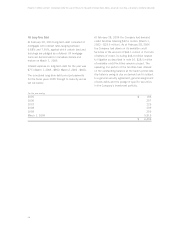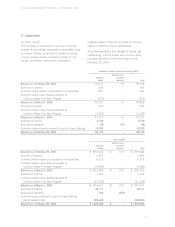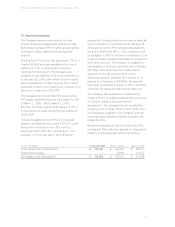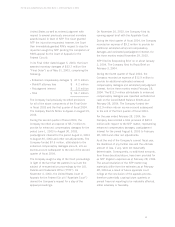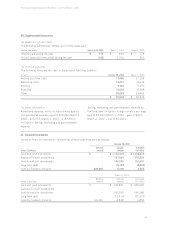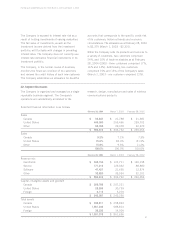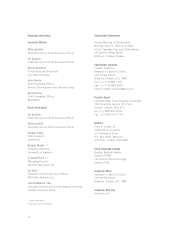Blackberry 2004 Annual Report Download - page 58
Download and view the complete annual report
Please find page 58 of the 2004 Blackberry annual report below. You can navigate through the pages in the report by either clicking on the pages listed below, or by using the keyword search tool below to find specific information within the annual report.
56
Research In Motion Limited • Incorporated Under the Laws of Ontario (In thousands of United States dollars, except per share data, and except as otherwise indicated)
For certain of the Company’s financial instruments,
including trade receivables, other receivables,
accounts payable and accrued liabilities, the
carrying amounts approximate their respective fair
values due to their short maturities.
The Company is exposed to foreign exchange risk as
a result of transactions in currencies other than its
functional currency the U.S. dollar. The majority of
the Company’s revenues in fiscal 2004 are
transacted in U.S. dollars. Portions of the revenues
are denominated in Canadian dollars, Euros and
British pounds. Purchases of raw materials are
primarily transacted in U.S. dollars. Other expenses,
consisting of the majority of salaries, certain
operating costs and all manufacturing overhead, are
incurred primarily in Canadian dollars. At February
28, 2004 approximately 2% of cash and cash
equivalents, 26% of trade receivables and 18% of
accounts payable and accrued liabilities are
denominated in foreign currencies (March 1, 2003
- 14%, 13%, and 8%, respectively). These foreign
currencies include the Canadian Dollar, British
Pound, Euro, Australian Dollar, Hong Kong Dollar,
and Japanese Yen.
To mitigate this risk, the Company maintains net
monetary asset and/or liability balances in foreign
currencies and engages in foreign currency hedging
activities using derivative financial instruments. The
Company does not purchase or hold any derivative
instruments for speculative purposes.
To hedge exposure relating to anticipated foreign
currency transactions, the Company has entered into
forward foreign exchange contracts to sell U.S.
dollars and purchase Canadian dollars, to sell Euro
and purchase U.S. dollars, and to sell British
Pounds and purchase U.S. dollars. These contracts
have been designated as cash flow hedges, with the
resulting changes in fair value recorded as other
comprehensive income, and subsequently reclassified
to earnings in the period in which the cash flows
from the associated hedged transaction affect
earnings. The maturity dates of these instruments
range from March 2004 through to February
2007.These cash flow hedges were fully effective at
February 28, 2004. As at February 28, 2004, the
unrealized gain on these forward contracts was
approximately $5,468 (March 1, 2003 - $3,439;
March 2, 2002 - loss of $1,478). These amounts
were included in Other current assets and Other
comprehensive income. Approximately $4,791 of
the unrealized gains on the forward contracts will be
reclassified to earnings in fiscal 2005.
To hedge exposure relating to foreign currency
denominated long-term debt, the Company has
entered into forward foreign exchange contracts to
sell U.S. dollars and purchase Canadian dollars.
These contracts have been designated as fair value
hedges, with gains and losses on the hedge
instruments recognized in earnings each period,
offsetting the change in the U.S. dollar value of the
hedged liability. The maturity dates of these
instruments range from March, 2004 through to
March, 2005. As at February 28, 2004, a loss of
$69 was recorded in respect of these instruments
(March 1, 2003 - gain of $419; March 2, 2002
- $nil). This amount was included with Selling,
marketing and administration.
During the prior year, to satisfy short-term cash
requirements, the Company entered into a forward
exchange contract to purchase U.S. dollars and sell
Canadian dollars with a notional value of $1.3
million. The contract carried an exchange rate of
U.S. $1.00 equals Canadian $1.5313, and it
matured on March 3, 2003. Due to the short-term
nature of this contract it was not designated for
hedge accounting and a loss of $42 was recorded in
respect to this instrument.
The Company is exposed to credit risk on derivative
financial instruments arising from the potential for
counterparties to default on their contractual
obligations to the Company. The Company
minimizes this risk by limiting counterparties to
major financial institutions and by continuously
monitoring their creditworthiness. As at February
28, 2004 the maximum exposure to a single
counter-party was 43% of outstanding derivative
instruments (March 1, 2003 - 37%).
The Company is exposed to market and credit risk
on its investment portfolio. The Company limits this
risk by investing only in liquid, investment grade
securities and by limiting exposure to any one entity
or group of related entities. As at February 28,
2004, no single issuer represented more than 4% of
the total cash, cash equivalents and investments
(March 1, 2003 - no single issuer represented more
than 5% of the total cash, cash equivalents and
short-term investments).


